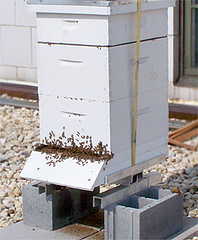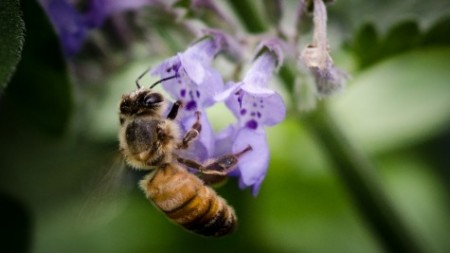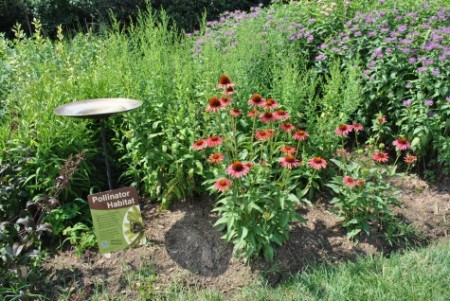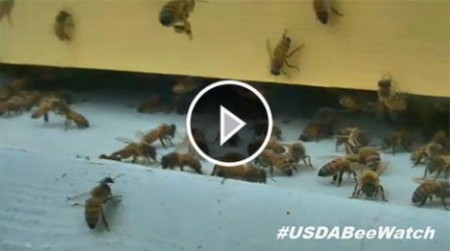At the ribbon cutting of the USDA Headquarters People’s Garden in April 2010 plans were already in place to install a beehive on the roof of the Whitten Building as well as a “bee-cam” so anyone anywhere could learn about bee activity. USDA’s newest ‘buzzing’ residents were welcomed on Earth Day but the bee cam was put on hold. 18 gallons of honey later, that idea has finally come to bee. You can now #USDABeeWatch 24/7 at www.usda.gov/beewatch.
So what will you see on our bee cam? This time of year, the camera – placed several feet from the entrance of the hive – shows female worker bees entering and exiting the hive gathering nectar and pollen (both collected from flowers) to convert into honey. Be on the lookout for bees carrying a load of pollen on their hind legs. As bees groom, they’ll move the pollen onto their back legs creating a pellet of pollen. A small amount of nectar is used to stick the dry pollen together.

The People’s Garden Apiary is home to two beehives and approximately 40,000 Italian honeybees.
The availability of pollen and nectar from flowering plants in surrounding landscapes is very important to the growth, development and productivity of any honeybee colony. Populations of honeybees, native bees and other pollinators like birds, butterflies, beetles and bats have declined due to habitat loss, disease, adverse weather, and other conditions. We need pollinators to pollinate most of our flowering plants giving us the foods that give our diet nutrition, diversity and flavor.

A honeybee from the People’s Garden Apiary visits the perennial Nepeta cataria (Common name: Catnip) in the herb garden of the U.S. Department of Agriculture (USDA) headquarters People’s Garden in Washington, D.C.
Helping pollinators is essential. That’s why we’ve adopted pollinator-friendly gardening practices at USDA Headquarters and encourage you to do the same. Simple actions you can take on your farm, ranch or garden to create or improve pollinator habitat include:
- Planting a variety of native flowering shrubs, trees and wildflowers that bloom continuously throughout the seasons; allowing small plants like clover in your lawn instead of trying to eradicate these “weeds” with herbicides.
- Finding non-chemical solutions to insect problems;
- Providing a source of clean water for birds and other pollinators such as a birdbath;
- Using native plant species that are from your ecoregion;
- Leaving dead foliage on native perennials as a source of food and nesting material for wildlife in winter; or
Become involved. Plant a small pollinator garden and experience the pleasure of observing pollinators in your garden. Share your findings with us using hashtag #USDABeeWatch. Most importantly, get outside with your family and friends and explore the natural and urban habitats that we share with pollinators and flowering plants.

Flowers add beauty and attract pollinators to any garden. Plant a pollinator-friendly garden or window box to show your support for pollinators. Remember to bee patient. It may take time for native plants to grow and for pollinators to find your garden.










